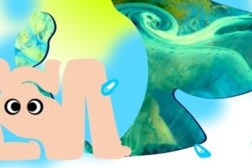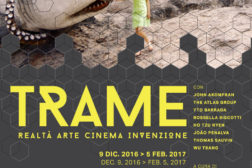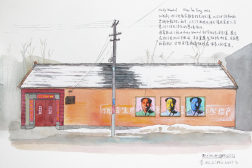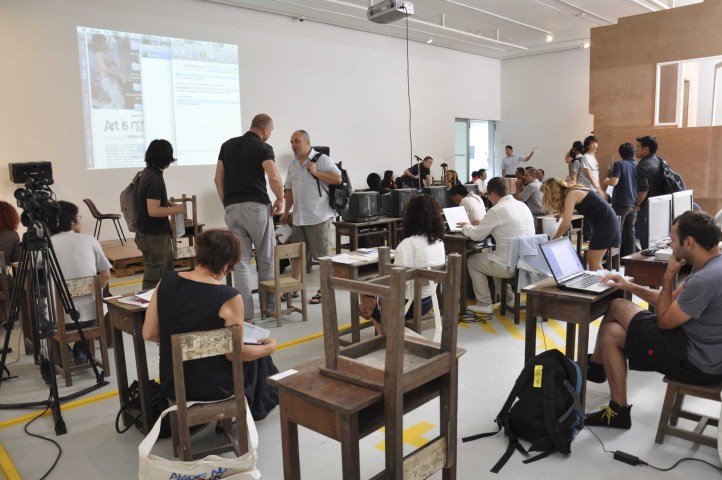
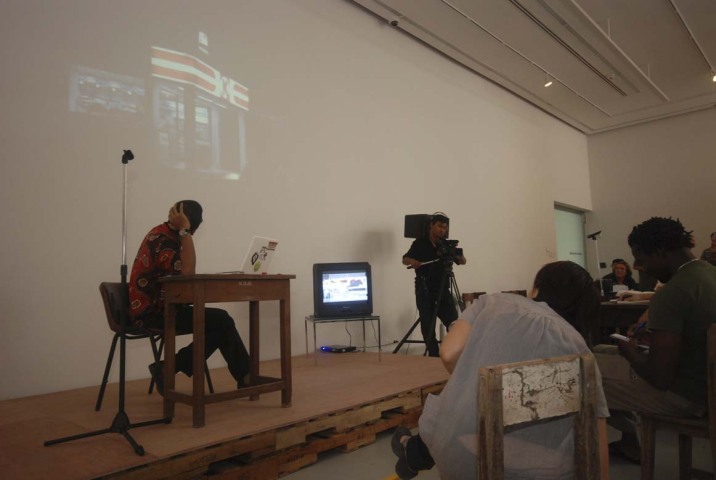
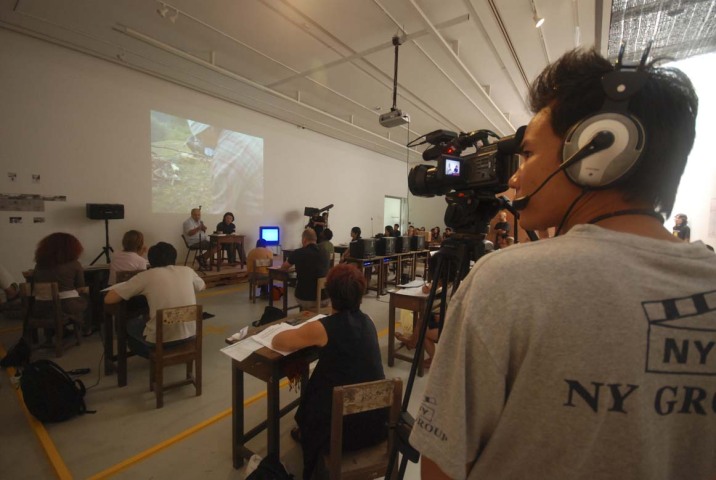

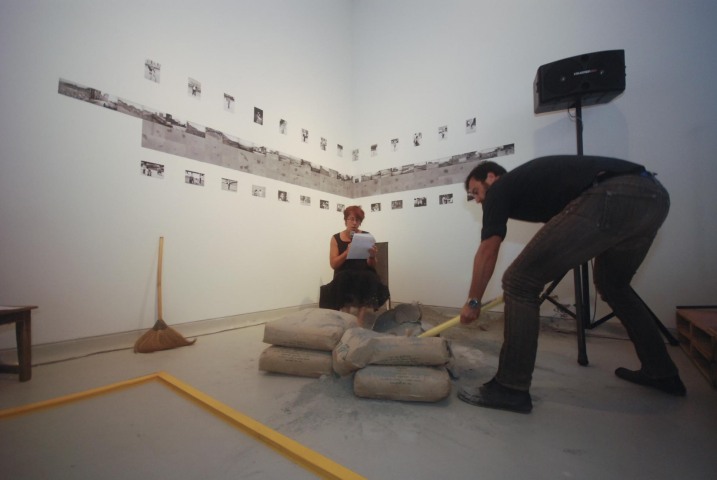
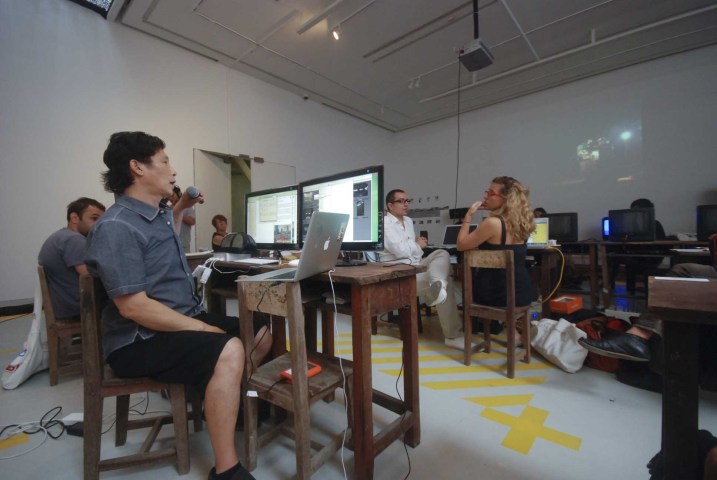

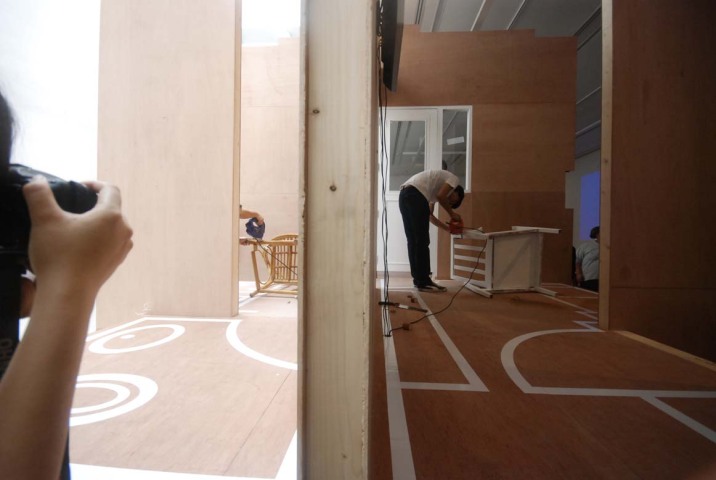



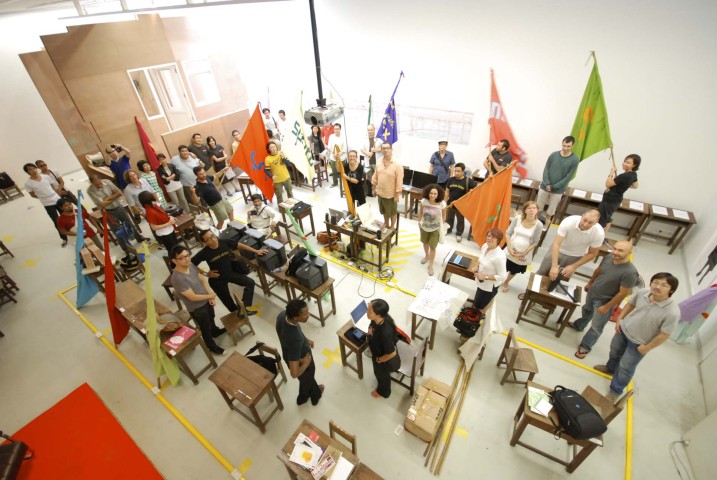
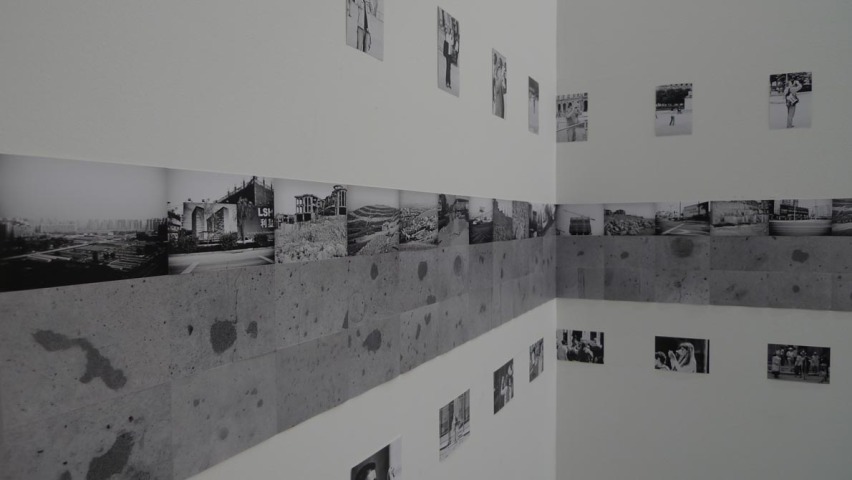
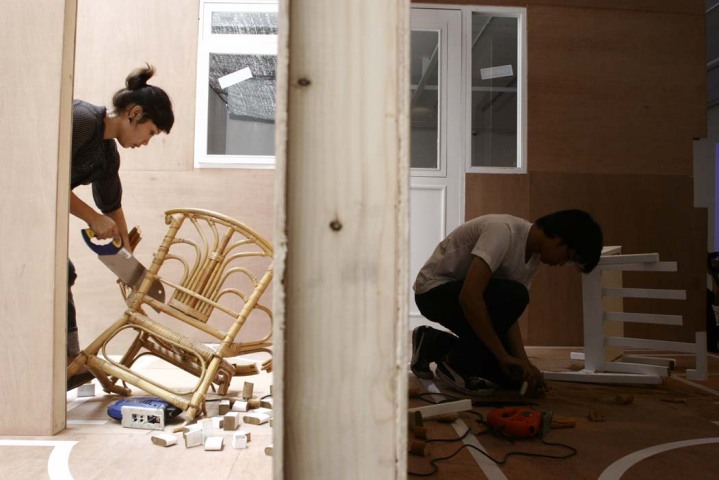

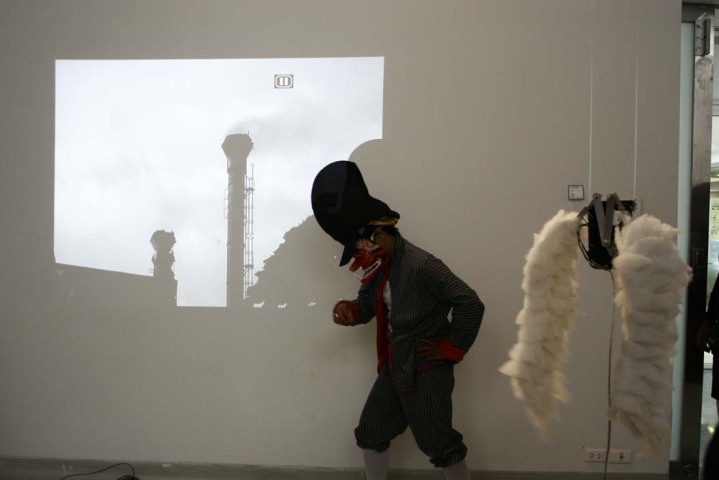



Arthub Summit: The Making of the New Silk Roads (Bangkok)
Prologue: Before the Symposium
More than thirty renowned scholars, artists, and practitioners in visual arts, performance, and other cultural fields from around the world will gather in Bangkok to discuss and reflect on the dynamic, ongoing echoes of the ancient trading route Silk Road and its multiple dimensions in a four-day symposium titled The Making Of the New Silk Roads from Thursday, August 27, through Sunday, August 30.
Hosted and organized by ArtHub, the symposium aims to reassess the complex interconnections within Asia’s cultural and artistic spectrum at the beginning of the 21st century. It took place at the Bangkok University Gallery (BUG), in collaboration with the Prince Claus Fund, Bangkok University, National Research Center of the Kingdom of Thailand, with additional support from Mondriaan Foundation and ANA (Singapore), the summit will feature Arthub’s “collaborative intelligence” participants from across Asia including China, Thailand, Indonesia, Malaysia, Philippines, Hong Kong, Singapore, Turkey, Georgia, Afghanistan, Kyrgyzstan and Kazakhstan, and beyond, along with additional participants from the prestigious Prince Claus Fund Network Partnership Program.
This four-day program will not only feature lively discussions of shared experiences among peers, examining the recent rapid developments in Asia, and among its cast of characters, issues, and mediums, but also provide an exciting forum, reflecting on the dynamic, ongoing echoes of the ancient trading route of the Silk Road in its multiple dimensions. Proposing the Silk Road as a variable metaphor for instable connections and uncertain achievements, and taking it as a departure point for continued reflections upon Asia’s cultural landscape, Arthub aims to carry this out by inviting artists, curators, and cultural thinkers from a wide array of viewpoints to go beyond a recitation of ideas or positions, and instead to bring presenters, participants, and audiences together as they explore, challenge, articulate, or nourish the possibilities of performative responses to Silk Road’s highly constructed symbolisms.
Each artist and/or scholar will present a specific artwork/presentation/installation that not only implies a possible story-telling about a specific condition from his/her respective, particular context such as issues of cultural circulation, social/political activism, and the marketplace) but also that tests the idea of Silk Road’s potency for cultural hybridity across Asia in general. To be presented in the form of a series of newly commissioned works including installations, lecture-performances, TV shows, radio interviews and publications, this collaborative symposium will put a special emphasis on process-oriented, and research-, dialogue-based artistic positions across Asia. Through the means of commissioning new responses, establishing dialogue months prior to the symposium, and enabling an alternative live context for investigation of dynamic cultural issues by its very own very actors, Arthub is committed to inspiring new forms of artistic and aesthetic experiments in China and rest of Asia.
Arthub also aims to re-examine the contested idea of the cultural encounter with the “other,” and turn these peer-to-peer encounters into a generator of new impulses for the analysis of complex historical processes within the cultural systems in Asia. The symposium will be video recorded, and a film + catalogue will be produced. The outcome will be geared towards touring as an exhibition later in 2010. Yet as with the symposium’s multiplicity of strategies, the resulting exhibition will be open for constant negotiation and reformulation. The symposium is organized by Arthub’s Davide Quadrio, Defne Ayas, and Ark Fongsmut, with coordination support from Monvilai Rojanatanti.
The outcome (exhibition) was open to public until September 2, 2009
To see the video (8:50 minutes) of the event, click here.
For press release please click here.
Participants: Ark Fongsmut, independent curator, Bangkok University Gallery, Thailand; Agung Kurniawan, artist/curator, Indonesia; Alexander Ugay, artist, Kazakhstan; David Cotterrell, artist, UK; Els Silvrants, curator, Belgium/Beijing Theatre in Motion; Gary Pastrana, artist, Philippines; Ho Tzu Nyen, artist, Singapore; Howard Chan, artist/curator, Hong Kong; Arahmaiani, artist, Indonesia; Jiang Jun, Urban China, Beijing China; Kyong Park, architect, University of California USA/Korea; Lina Saneh, artist, Lebanon; Mu Qian, Ethnomusicologist, China; Nikusha Chkhaidze (Nika), artist, Georgia; Onno Dirker, artist/architect/researcher, Netherlands; Pratchaya Phinthong, artist, VER Gallery, Thailand; Rahraw Omarzad artist, Afghanistan; Samah Hijawi, artist, Space Makan, Jordan; Shaarbek Amankul, artist, Kyrgyzstan; Stefan Rusu, artist/freelance curator, Center for Contemporary Art, Chisinau, Moldavia; Hakan Topal, artist, Xurban.net, Turkey; Seph Rodney, Ph.D. candidate at the University of London-Birkbeck College, UK; Veronica Sekules, Head of Education at the Sainsbury Centre, UK; Adeline Ooi, curator and arts writer, RogueArt, Kuala Lumpur, Malaysia; Agung Hujatnikajennong, artist, Indonesia; Zoe Butt, curator, Long March Project, Beijing/South East Asia (sharing work by artists Erin Gleeson, Rattana Vandy, Nguyen Trinh Thi; with a performance by Le Huy Hoang); Supersudaca, architect/artist collective, South America/The Netherlands; Edwin Zwakman and Liu Gang (the Netherlands/China); Speedism, collective, Belgium/Germany; Supernormal, architect/artist collective, Thailand.
Part I: The Making of the New Silk Roads: Arthub’s summit in Bangkok
by Defne Ayas and Davide Quadrio
“Symposium originally referred to as a drinking party (the Greek verb sympotein means ‘to drink together’) but has since come to refer to any academic conference, or a style of university class characterized by an openly discursive format, rather than a lecture and question–answer format. The sympotic elegies of Theognis of Megara and two Socratic dialogues, Plato’s Symposium and Xenophon’s Symposium all describe symposia in the original sense. The Greek symposium was a forum for men to debate, plot, boast, or simply to party with others. They were also frequently held to celebrate the introduction of young men into aristocratic society. Symposia were also held by aristocrats to celebrate other special occasions, such as victories in athletic and poetic contests.” Definition by Wikipedia
Even in Bangkok, miles away from Hellenic influences, Plato came into the picture. Each night of Arthub’s Silk Road Summit ended with Thai massage and local delicacies, and eventually the Latin American architectural collective Supersudaca offered everybody in the room a bottle of cold Thai beer to drink as they sat down to sum up the events of the day.
Assessment of the complex interconnections within Asia’s cultural and artistic spectrum was a key motivation for this gathering. This was achieved by bringing together Arthub’s “collaborative intelligence” participants–some from a half a decade of active work and correspondence in the field and others from more recent encounters. Through establishing dialogue months prior to the symposium, and commissioning new responses, Arthub designed it all so that peer-to-peer encounters were enabled and turned into a generator of new impulses for the analysis of complex historical processes within the cultural systems in Asia.
Thirty-five brilliant practitioners in visual art, performance, and other cultural fields from around the Asia (see Seph Rodney’s notes below) traveled down to the hospitable Bangkok BUG headquarters. There, during the Monsoon days of August 27-30, they examined the ongoing echoes of the ancient Silk Road trading route in a four-day symposium titled The Making Of the New Silk Roads. Representatives were from all around Asia, including China, Thailand, Indonesia, Malaysia, Philippines, Hong Kong, Singapore, Turkey, Georgia, Afghanistan, Jordan, Lebanon, Korea, Moldova, Kyrgyzstan and Kazakhstan, along with very recently initiated participants from UK, Netherlands, and Argentina, with zero-point freedom to interpret the gathering.
Having already done their artistic validation globally (East and West of their geo-political coordinates), The Making of the New Silk Roads’ participants gathered to take a stab at the Silk Road, not only as a variable metaphor for instable connections, but also to embrace its ambiguity as a departure point for continued reflections upon Asia’s cultural landscape. Testing the Silk Road’s potency for cultural hybridity is a “mission impossible” from its outset, one which Thai artist Surasi Kusolwong challenged with the comment, “where is [this mission]’s heart and head?” at the end of the summit.
Arthub embraced the fragility of the context (with the conviction that fragility needs be embraced in the art world at this moment in time), and asked the brilliant minds of Asia to step up the challenge and go beyond the prescribed recitation of ideas or positions, as expected by validation platforms in formulaic environments, and instead challenge or nourish the possibilities of a “fragile” medium, namely performativity and research-based positions, in regards to the Silk Road’s highly constructed symbolisms.
Was this minimum expectation of risk-taking and examination achieved? The live context of the three days featured variable presentations of experiences against a “designed” classroom. It was set-up where everyone could be a teacher, a student, and a provocateur, and where they each could explore the dynamic, ongoing echoes of the ancient trading route of the Silk Road in its multiple dimensions. The architectural theme of “back to school” certainly created an intimate space, while somehow remaining both nostalgic and at the same time totalitarian (all chairs and desks were orthogonally spread in the space, a stage was located in front of them for presentations). Visitors occupied a line of hard seats at the entrance and at the back of the “classroom.”
At the beginning of the symposium, a stage was offered as place for experimentation, in order to challenge the limitation of such “Stalinian” design. This block of unidentified architectural space, neutral and yet open, was a monolith in the classroom: a memento, an allegory of constrictions and limits to be disrupted. It was the place to, as Arahmaiani printed on her T-shirt, “Stop Masturbating and Join the Revolution!”
It was not an easy act to interact within such a “free,” or maybe better to say “deliberately open” format, and slightly fragile moments emerged.
PART II:
New Roads, by Seph Rodney
The Silk Road―it was only later, after sitting with my memories of the conference that I realized that I had to look at this “road” as more than a conduit for information and objects. The original route has enjoyed historical emphasis on its conduct of goods, that is, its function as a means of commercial interchange. But this definition did not help me come to terms with the baffling array of artists and researchers who attended the symposium. I came to view the Silk Road as more than a historical artefact alone, but as a metaphor for a route, that is, a strategy for traveling, for negotiating one’s way through cultural space. By ‘culture,’ I mean the specific rituals and practices that characterize a particular group and their way of life. Both senses taken together made it possible to understand how this conference consisted of older strategies for artistic inquiry and cultural evocation, like well-worn paths that had conducted many travelers. Yet, it also seemed to contain moments in which the artists and scholars found their legs and made new routes.
Now, I look back the way we came, at what these different roads might tell us about this experiment in Bangkok, and what they might indicate about the future. Such diverse and deeply considered forms of analysis and displays of cultures as offered by the roster of artists and researchers only began to resolve themselves for me once I understood them as differing approaches. The academic presentations helped make this clear. Both Kyong Park and Jiang Jun presented analytical work (rather than performative) that demonstrated the extent to which the antiquated Silk Road was a mechanism for exchange that was significantly internal to the Asian continent. Jiang demonstrated that following the trail of insignia, signs, and emblems with a particular rubric in mind he could find meaningful distinctions, and thus see separations between the cultures of Mongolia and China that are historical, but also, by his claims, structural. Kyong delineated the complexity of current cultures across Asia, with its blossoming economic and legal institutions, and changing social and spatial forms of organization. He showed that mapping as an attempt to configure what is happening can be a mostly futile exercise.
Both presentations struck me as remarkably self-referential. The logic underpinning these analyses presumes that the cultures and subcultures within the East may be understood by comparison with each other, rather than to cultures outside the continent. This logic puts to one side that paradigmatic division of East and West, so often thrown up as a key division among questions of how a cultural practice is recognized as constitutive of a culture. This logic then suggests a different way for me to appreciate the significance of the old Silk Road, known for bringing travellers into connection to others outside the borders. The other seems important. Indeed it is the notion of the ‘other’ that has troubled much of Western politics and political theory in the last century. At the root of this trouble is the conviction that knowledge brought from outside perspectives provokes a deep and productive (and even intolerable) self-awareness.
I wonder what lasting effects come from creating a road that essentially loops back on itself, ferrying people and cargo around a geographic area that although varied, is still contained within the Asian continental or cultural borders. By metaphorical extension, I wonder whether an approach, bound by certain internalized, intellectual borders, diminishes its travellers’ exposure to other perspectives that could contribute to self-criticality and self-awareness. Yet, I also recognize that a crucial aspect of a culture is the creation of a specific set of logics internal to the community. This set of logics is what gives a culture its character. Enacting them we might rightly consider political.
Our own politics, that is our relations of power with the conference organisers and with the structure of the symposium itself, were disjointed and faltering. On the first day we made our presentations in classrooms at the Bangkok university, squeezed behind tiny desks and squeezed into tinier chairs, all facing the front of the room like obedient pupils. I had a conversation with a few of the artists and scholars in our community, after the first seven hours of rigorous slide-talk-slide presentations that had most of us feeling physically cramped and vaguely disquieted. We brewed insurrection. Talking with each other we concluded that this scholastic environment didn’t work for us and that we would challenge it: the next day we would change all the desks around, make a circle or square in seminar format. We would revolt, and make our own space. It did not happen. That idea somehow died―perhaps through inaction, or indifference, fear, or forgetfulness.
Apparently, we did not fully appreciate that these imposed rules were there only to be broken. At the end of the first day, Davide Quadrio said to me that he too was hoping for more provocative action and thought that as everyone settled into the layout they would become more comfortable and would act for free. Then at the end of the symposium, Davide reminded me that he had both written and said repeatedly that freedom of action within the space was completely up to the participants. He and Defne Ayas were happy to receive whatever performative actions people thought up to challenge and remake the space.
Though our internal politics (to my knowledge) failed to cohere in action, we saw illustrations of political action, indeed action dramatized as an individual striving against repression. We witnessed this in the performance work of Nika (Nikoloz Chkhaidze). Nika, for what seemed like a punishing length of time, pushed himself against a barrage of water directed from a fire hose. The work was both painful and beautiful in decontextualizing the individual, almost ineffectual, gesture against control. It both staged and demonstrated risk: we saw Nika’s body pummeled into the concrete floor as he pushed back in a Sisyphean struggle to overcome, to get to the man holding the tool of violent oppression. Then, unexpectedly, Onno Dirker, playing the part of the repressive state apparatus, lost control of the hose (vehicle of repression) and its power sprayed everywhere. It wet everyone; Onno himself was bruised by landing hard on his elbow while trying to regain control. It is likely significant that this work took place outside. In restaging history in that isolated act of hosing down the dissident, the work transcended itself. It allowed in the accidental, and thus real risk. Nika could not have planned to show, but nevertheless did, that the regime sometimes falters. Thus it was a work that proposed a certain strategy for collaboration between artists, for representing political determination: it did so through dramatization, that though decontextualized, was compelling in its bodily risk.
Indeed without the sense of risk, or without the active challenge to the boundaries of the space performative action fell very flat. Arahmaiani’s work was illustrative of this failure. Her performance consisted of standing on the balcony of the Stephan Rusu’s Flat Space piece, waving a hybrid flag of no clear provenance and no specific agenda. The work suggests political activism enacted in the simple deed of waving a handmade flag, but it illustrated activism without clarity. Its trite formulation could not indicate where our energies needed to be placed, or what could be at stake, and perhaps most importantly, what the cost will be. This piece stood in contrast to much of the other work in the symposium, that though silent on historical specificity, was articulate in its dramatization or in its methodology for comprehending the significance of a cultural practice.
Some of the artists and scholars were quite successful at making a case for how particular cultural practices define a community and allow the participants to constitute a sense of self around and through these behaviours. Agung Koerniawan presented work concerned with how people who live in a particular city come to recognize it, and I would suggest, their place in it. His work, largely documentary footage of the nighttime activities of a particular group, with recordings of their own voices and depictions of their music, depicted these night lives as the socially significant ways they understood being part of a community.
This approach I found deeply ethical and concerned with social inclusion. There was a more subtle set of politics at work here: not a politics of rebellion, but of recognition. This grassroots ethic means to take as its foundational perspective, the experience of the worker, the shop owner, the farmer and student. Thus it works in opposite fashion to a colonial history that tended to privilege the view from those at the top of the social hierarchy.
This ethic was demonstrated performatively as well, through Agung Hujatnikajennong’s video of a dancer/performer sweeping through a factory and blessing the machines in his path. That work connected ritual to economic necessity, performance to the material necessities of a community. It also served as a piece of historical analysis in showing indigenous practices, that eventually become embedded in a culture as ritual, may be tied to self-preservation.
Other artists and scholars employed these strategies. In Alexander Ugay’s documentary work, or Shaarbek Amankul’s videos of Shamans, Mu Qian’s examination of the Pentatonic Workshop, or Zoe Butt and the Long March Project, small, rarely seen pathways of culture were made visible. These works ordered for our view cultural practices such as singing, reciting poems, exorcizing demons, etc. In these works the presenters used a strategy of documentation that de-emphasized the filmmaker’s creative influence, thus producing work that seemed authentically amateur in its making of a video or filmic record. This strategy also conversely emphasizes the significance of the recorded event itself. The effect is to chronicle ways of life, concretizing them in an anthropological record, and reminding others that the examined culture continues to exist.
There was, in these presentations, a sober celebration of ritual practices. Just as each time a family’s members gather around the dinner table and enacts the ritual of eating together to both say who they are to each other and to confirm that each one is a member of the familial community, these works kept an inheritance circulating in the community. These works made memory a live endeavor. Thus, remembering made a case for the necessity of remembering.
Howard Chan’s projects complicated this approach in placing cultural preservation of every-day ritual in the contexts of both community self-awareness and curatorial strategy. In doing so he conveyed the primary reason practices and knowledge produced from within a community need to be preserved: because their institutionalization and recognition gives a dignity to their day-to-day lives that otherwise is rarely given. His Museum of the Streets allows those who visit to recognize themselves in images that are otherwise destined for easy consumption. Tourist images that proliferate everywhere function in just the opposite way. They are empty and attached to nothing. Through programmes such as the Refrigerator Project, Chan takes the image back to the simple quotidian usefulness of the refrigerator in the family home in order to talk about generational differences, social mobility, class. Crucially these images are not intended for foreign export as a commodity, but as internal communications.
This approach seemed fresh to me, a new conduit, built on top of the old road that routed exoticism to a western world hungry for consumables, a world in which citizens have learned to comprehend themselves through consumption. The old road imagines cultures it made connections to as sources of delectable goods to consume. At one point we were confronted with this old, reactionary approach to imagining the connections between differing cultures and we laughed at how ridiculous the idea seems to us now.
Felix Mandrazo and Max Zolkwer of Supersudaca, presented us with a tourist’s suitcase full of commoditized images, images full of rapture over colourful toys and effervescent objects. Their presentation was a clear and jubilant illustration of precisely the attitude of someone who travels to other cultures to use them as a source of pleasure and escape. Thus cultures and their practices become cheap, empty souvenirs―each representation is disposable, the image, the object, the trip, the story. Many of us laughed at this way of representing their travel experience. Indeed, with this laughter we distanced ourselves from that old Silk Road. We recognized that this perspective was itself an antiquated artifact. Anger was another response: Agung Koerniwan verbally objected and walked out of the room during the presentation. He later said, in explanation, that humour is difficult to pull off and can be subversive when it is powerfully employed, but if not knowingly employed, risks failing and becoming a bad joke. But I think he missed the opportunity to recognize this encounter as genuine confusion based on the clash of signifiers that on the one hand are held as constitutive of the dignity of people, and on the other a source of disposable pleasure. There was a chance there to examine the ways that symbols take on meaning, and perhaps the most generous form of our politics was enacted then, when we spent some time wrestling with what Felix and Max had confronted us with.
In reconsidering the original road, we met with distinct ontologies, ethnicities, practices, and, in the work of Gary Pastrana, commingling. It was one of the most surprising works presented at the symposium. This make-shift hybridity, was illustrated in his work of taking two chairs, sawed and hacked to pieces, recombining them randomly with two workers simultaneously operating a glue gun and hammer and nails. The result was Frankensteinian, glue-sutured, contorted bodies of sculptural inelegance. Despite the ungainliness of the newly produced ‘chairs’ Gary’s work suggested questions of its potential uses for these new objects: they could not return to the functions they had fulfilled before. Therefore new uses would have to be imagined for them. This made me think of how disparate parts of our cultural history, the materials out of which we fashion well-used rituals and practices have a built-in resistance to being torn apart and recombined. They would not be recognizable and they may likely become useless.
Hakan Topal purposely and performatively articulated an argument for uselessness. He actively attacked the foundation of twentieth-century rationalized labour, endlessly repeated concrete structures, and the relentless consumption that would support all of it. Hakan physically savaged sacks of Portland cement, snapping me back from the brink of sleep and into presence with the sound of his striking shovel. Against a backdrop of a photograph installation of tourists taking pictures of themselves in various tourist spaces (again in consumption), and with Veronica Sekules sitting in a chair in the middle of his space and reading aloud, he tore the bags apart. As Veronica read out a text referring to political trauma and historical struggle, Hakan took the cement bags apart and shoved the grey, dusty material over Veronica’s feet, and everywhere around the space. His work spoke of un-building, of tearing down. He scattered the substance of modernity (Portland cement was an artificial compound that replaced natural cement and contributed to an accelerated building process at the end of the 19th century) recanting its knowledge, disavowing its claims. The failure of modern architecture to put at ease our cultural distinctions, or render them insignificant is well documented. Hakan placed himself outside of this continuity to argue that it must and can be stopped.
Other works at the symposium placed the body back into the question of cultural examination. David Cotterrell presented films of soldiers wounded in Afghanistan, presenting work that had a contradictory relationship with the speaker. In his work, the bodies of soldiers, blasted and battered, take on a dramatic presence in the operating theatre. In a slow-motion video record of surgeries being carried out warring bodies are made vulnerable by injury. These bodies become bodies over which the fight for preservation is waged. However the person making this struggle visible is manifestly opposed to war. David identified himself as a pacifist to us and presumably to the soldiers with whom he was embedded in Afghanistan. Despite this he put himself in harms way to concretize and then complicate his own response to war. His work poses question regarding invasion and preservation, cultures that meet in violent conflict and the aftermath of such encounters. In addition, the bodies of wounded soldiers are practically and symbolically held as the nation’s own, and in the surgery are fought to be reclaimed from the damage of war by an almost similar level of skill and loyal commitment.
In Lina Saneh’s presentation of a narrative about her own body, the very terms of individual ownership versus ownership by the culture or community are discussed. Lina presented a piece she had written in which she seeks to get rid of her body, piece by piece in direct denial of a proposed law that would prohibit the donation of body parts after death. Thus, she looked to graft onto local practices the conviction that her own body is her own, this despite that local customs refuse to regard the body as simply belonging to the individual. One conclusion to be drawn from her work is that the body is placed in a role of primary significance, as in Nika’s piece, where our politics are enacted and tested. She argues in essence that the body is where politics and political understanding begin.
At the last, the positioning of Ho Tzu Nyen was interestingly contradictory―he was both with us and not with us. He allowed himself to be represented for most of the symposium by a stand-in who went on to ask the kinds of questions only an outsider asks, naively and candidly. Why? And then what happens? How do you see this commenting on art in general? These questions could have, with a bit more context, pushed us to look at the art practices presented during the symposium from the perspective of a spectator who can take little for granted. This strategy did also propose what seemed to me to be a new way of thinking the traverse between and among cultures: to be in it, but not of it, to stand slightly outside, looking, recording and mapping. Tzu Nyen did that long enough to get a sense of where to reposition himself in relation to us.
In the end he decided to document us, to show us to ourselves. This strategy seems to me to avoid the self-referentiality that threatens to reduce self-criticality. Tzu Nyen used this approach to produce a video of what he observed through from the vantage of being there/not there. I concluded, once back in London, that this strategy was the most convincing to me for negotiating the old Silk Road, while looking to both preserve significant cultural practices and discover new ones. Cultural meaning exists in passage and in flow; preservation should not mean consecration. As Els Silvrants said, it is crucial to step out of borders, ideologies and markets. It seems indeed to be crucial to take such a road out, and then just as crucial to take a road to step back in.
For the poem At the End of the Silk Road please click here.
PART III: Twitter-Minutes of Silk Roads…
Walking in, Bug and the people
Deputy Minister of Culture of Thailand will open the Silk Roads symposium tomorrow, joined by Surasi Kusolwong at 7:49 pm, August 26 (from the web)
Agung Kurniawan starts the day with archival projects related to the killing of 500,000 Communist Party members in Indonesia, 8:40 pm August 27 (from the web)
Jiang Jun of Urban China redefining “Asianness” vs “Chineness,” tracing oasis cultures as alternatives (premodernity) vs modernity, 9:24 pm, August 27 (from the web)
Howard Chan and Community Museum Project: here, 5:33 am, August 28 (from the web)
Javanese artist Jumpet’s performance leashes out a conversation between spirits, machinery from Colonial times until now, 8:30 pm, August 28 (from the web)
Ho Chi MingTrail’s Zoe Butt introduces Tianxia by Erin Gleeson, Rattana Vandy at 8:36 pm, August 28 (from the web)
Gary Pastrana, artist from the Philippines and his ‘on-going’ performance! 10:13 pm, August 28 (from the web)
Sign up for Call for Body Part Signature @callforbodypartsignature.blogspot.com! Lina Saneh Body-P-Arts project, 2:32 am, August 29 (from the web)
Rahraw Omarzad gave too quick of an art history download (Kabul), and presented his exhibition of women artists, along with his video, 6:53 am August 29 (from the web)
Cotterrell causes controversy with his work as a “war artist” in Afghanistan, 6:54 am, Aug 29 (from the web)
Samah Hijawi took over the Flatspace for her lecture based on a composite of Pan Arabist texts by General Nasser, 6:54 am, August 29 (from the web)
Onno Dirker is holding a cobra, poking at Jiang Jun’s and everyone else’s symbol-picking across Asia, 6:55 am, August 29 (from the web)
Superdaca brings the beer, the cheers, along w/ a funny, superficial treatment of Shanghai, raising a few hairs. Agung K. leaves the room, 6:56 am, August 29 (from the web)
Ho Tzu Nyen’s TV show on red carpet, w/ sponsor logo in the background. Ruminations on role/perception of art, then Arahmaini is asked on stage with Seph Rodney, 8:42 pm, August 29 (from the web)
The morning kicked off with an introduction by Onno Dirker on Baghdad Cultural Map, indexing life in 2003 and 2004 (before the TV show), 8:46 pm, August 29 (from the web)
Thank you to all for making it happen! The last session revealed a clone of Ho Tzu Nyen, and ended w/ calls for risk-taking and multiplicity, 8:31 am, August 30 (from the web)
Making of New Silk roads’ exhibition is on in BUG until September 2 2009, come visit! 11:02 pm, August 30 (from the web)
FULL SCHEDULE:
Day I:
Albertus Agoeng Koerniawan
Title: A Pilgrimage of Falsehood
How to touch traumatic and frightening pasts despite our refusal to see them? When memories are too sad, too scary, too bare, Koerniawan converts these vivid, stark materials into the fictional, the false face of an image, video, documentation. Is fiction a skin that is softer, cooler, more comfortable to the touch? Can it be a way to trick ourselves into remembering?
Agung Kurniawan (1968–East Java, Indonesia) studied archeology and graphic art. His themes are violence and oppression, such as in political systems. He examines this in a very subtle way. He also derives inspiration from fantasy worlds and the ongoing automation of society, using computers and robots in his work. He questions whether these developments actually improve or diminish the quality of life. Over the years new themes come up. Where he started subtly protesting the Suharto regime, his focus now lies on confrontation with a taboo society. Agung Kurniawan has had exhibitions in Indonesia and Japan, Korea, Singapore and Australia, as well as Europe. He has exhibited in The Netherlands, in 2000, with the exhibition AWAS in Museum Nusantara–Delft.
Stefan Rusu
Title: The Flat Space
How can we challenge the fixed functionality of a private space? The Flat Space project by Stefan Rusu proposes to do so by stripping down private space and exposing to view what it represents. The Flat Space design replicates the apartment space created by socialist society standards within urban landscapes of several East European cities, with an idealist functionality and aesthetics. Rusu uses this hollowed out version of a typical habitat to look through to the new, modern, individualist concerns of social status by a population of workers wanting a private space in the city, against a perhaps contradictory relation to the ultimate uniformity of these cities’ urban planning schemes.
Stefan Rusu is an artist and curator, currently based in Chisinau, Republic of Moldova and Bucharest, Romania. His artist and curatorial agenda is closely connected to processes and changes which occurred in the post-socialist societies before and after 1989—the effects of which are ongoing. Among his preoccupations are aspects of mass-manipulation techniques, political engineering strategies,and tactics of colonization and culturalization that culminated in some cases with the construction of artificial entities—as is the case of the Republic of Moldova. Rusu was trained as a visual artist and later extended his practice to curating, managing, and fundraising projects, editing TV programs, producing experimental films, TV reports and documentaries.
Samah Hijawi
Title: Arts And Culture (TBC)
The project is experimental research work concerned with looking at the structures and systems that have contributed and continue to contribute to the development of visual arts in Jordan. The artist has chosen to look at different elements which each present a different ‘definition’ of visual arts in Jordan, including a screening of video works by artists who have been in a residency or whose works have been screened in Makan. This will be co-curated by Ola (or Makan).
Samah Hijawi is a cross-disciplinary visual artist whose recent projects have focused on working in public spaces to include audience participation. Hijawi is also a cultural manager in several local independent projects in the visual arts, and works as a consultant with Makan Art Space where she has been involved in workshops for young people in collaboration with the Municipality of Amman, among other projects. She is also a writer on contemporary Jordanian arts with contributions in several local and international publications, and also lectures in Contemporary Art in the Arab World.
Jiang Jun
Title: China and Mongolia: Twin Pre-modernities in the East End of the Silk Road
The proposal for the “performative symposium” would be something between questions and answers, an index for important historical/geographical/political/economic questions and possible artworks/designs/ideas as answers/responses to these questions. The basic interrelations between China and Mongolia could be extended to many of China and Mongolia’s neighborhoods and the interrelationships in parallel dimensions of farming/the nomadic and premodernity/modernity. In this way more responses from other contexts may be collected to rebuild a new silk road—trading interrelated Q and A’s and the stimulated artworks.
Jiang Jun Designer, editor and critic, has been working on experimental urban research, exploring the interrelationship between design phenomenon and urban dynamics. He founded Underline Office in late 2003 and has been the editor-in-chief of Urban China Magazine since the end of 2004, in the mean time working on the book Hi-China. Born in Hubei in 1974, he got his bachelor’s degree in Tongji University in Shanghai and his master’s degree in Tsinghua University in Beijing, and is now teaching in Guangzhou Academy of Fine Arts.
Hakan Topal
Title: Concretescape, Softcity
In the contemporary moment what is the meaning of the urgency to redevelop, to renovate? What is being renovated and where does it occur and at whose behest? Is the very scale of urban projects what fascinates us, or is it a persisting desire for a utopia? During the last decade, enormous urban projects permanently changed the cityscapes around the world but does this hide a rejection of what already is there? In his performance/lecture Hakan Topal will create a landscape utilizing portland cement, plastic toys and fake flowers to critically evaluate current artistic strategies and examine concepts of ‘fascination’ and ‘distaste.’
Hakan Topal is a media artist, living and working in New York. He studied engineering (B.S.), Gender and Women Studies (M.S.) and he is currently a Ph.D. student in the Sociology department at the New School for Social Research, New York. As an artist he has realized one-person exhibitions, performances, video projects and photo-essays in addition to publishing works in various journals and catalogs. He worked as a researcher at GISAM, Audio Visual Research Center at METU, Ankara, as the New Media Projects Manager at the New Museum of Contemporary Art, New York, and as the Technical Director for the Prospect 1 New Orleans International Biennial, produced and managed numerous digital installations, media projects and websites.
Functioning as an international collective since 2000, xurban_collective has members located in Izmir, Istanbul, Linz, and New York City. Core members of the group are Guven Incirlioglu and Hakan Topal, whose transatlantic collaborations take the form of media projects and installations. xurban_collective’s approach involves questioning, examining, and discussing contemporary politics, theory, and ideology. xurban_collective exhibited internationally including projects in institutions such as the 49th Venice Biennial (2001), the 8th International Istanbul Biennial (2003), PS1/MoMA (2005), Apexart (2004), Exitart (2005) and ZKM–Center for Art and Media, Karlsruhe (2005). Their writings and online projects can be found here.
Alexander Ugay
Title 1: Central Asian Project, UK + CA
What are the possibilities of understanding and mis-understanding in meeting the other—especially when the other is met across the East/West divide? What are the critical appreciations of the other’s place of origin that surface through an exchange of others? The Central Asian Project, UK + CA produced an archive of material on DVD, for a project that took place from 2003-2008. It will be shown via three computers; participants/public can discover this mini-archive themselves and comment on the project by using paper catalogs.
Title 2: Flat-space in Co-operation with Stefan Rusu
Ugay proposes to install 2 videos/animations of his own making into the Flat Space, since the styles of both projects have a pro-Soviet spirit. This creates a feeling of dialogue between their projects and their common Soviet legacy.
Alexander Ugay was born in 1978 in Kyzilorda, Kazakhstan. He graduated from Kyrgyz State University of Low in 2002. He is a member of Bronepoezd group, and a photographer and video artist. He is based in Almaty. Selected exhibitions: 2002, No-Mad’s Land, the House of world Cultures, Berlin, Germany; 2005, 9th International Istanbul Biennale, Turkey; 2006, Plug In, the exhibition of new museum’s collection by Vanabbemuseum in Eindhoven, Netherlands; 2007, Muzykstan Media-a generation of contemporary artists from Central Asia, Central Asia Pavillion at the 52nd Venice Biennale, Italy; 2008, Tanz auf dem Vulkan, IFA gallery, Berlin, Germany; 2009, Younger Then Jesus, New Museum, New York, USA.
Els Silvrants + Speedism + Edwin Zwakman + Liu Gang + Baby
Title: Instant Future–Two Narratives and a Scenario
How much now is the future? When we playfully juggle the difference between real fake and fake real, does the future become pure allegory? How can we map out the interactions between imagery and reality in China’s new spectacle economy, transcapitalist experimentations and 400 new cities for 2020? Els Silvrants will show two narratives developed by two artist-duos* who have both worked in Beijing LAB on a project in the frame of Instant Future. They aim to do so in a semi-static (photographs) and semi-interactive (lecture-skype performances) fashion with a theoretic scenario on China’s futurscape as a talkshow between them, mediated by Els Silvrants of TIM/LAB.
*Conceptual artists-photographers Edwin Zwakman (Netherlands) and Liu Gang (China), and artists-architects Speedism who are Julian Friedauer (Germany) and Pieterjan Ginckels (Belgium)
Els Silvrants is a Sinologist. She leads Theatre in Motion (TIM), a non-profit organization founded in 2005 that runs an artistic research LAB in Beijing, embedded in a local cluster of artists, theorists, architects and scientists. TIM supports research projects of contemporary artists using cross-disciplinary information and/or research strategies. At the core of LAB lies the question what cross-disciplinary interaction can teach us about the specificity and added value of artistic research in broader research debate, and what kind of new organizational forms can be established to accommodate this.
Arahmaiani
Title: Stop Masturbating and Join the Revolution
In an ongoing project with a Singaporean artist, Iani Arahmaiani collaborates with young artists/activists/students on an ongoing community art project begun in 2007, called Flag Project. This means to deal with the problem of systems of control which manifest in different forms and on different levels in the region. This is an open-system kind of work/project—open for possibilities for output—though performance art will be the basic medium.
Arahmaiani was born in Bandung in 1961. Arahmaiani has exhibited widely in Southeast Asia, Japan, and Australia and also had work featured in the Traditions/Tensions show at the Asia Society and Global Feminism at the Brooklyn Museum. She was included in the Havana Biennale in 1997, Sao Paulo Biennale 1998, Kwangju Biennale 2003, Cities on the Move at P.S.1, and London’s Hayward Gallery in 1998, Corporeal Apology was presented at the Lyon Biennale in 2000, 11 June 2002 at Venice Biennale in 2003, Biennale of Moving Image, Geneva 2003 and Oberhausen Short Film Festival, Germany in 2009.
Kyong Park
Title: Pan Asia
What are the approaches offered by a combinatory art/anthropological practice to begin to understand the contemporary transformation of Asian regions and cities? Or rather, can a 21st century explorer go out and discover the new emerging lands and bring them back in image form and thereby make them meaningful? Can diverse and convoluted processes like transnational migration; the rise of supranational economic and legal institutions; evolution of extraterritorial zones and the social and spatial effects of globalization be understood visually? Kyong Park wants to decode an entire regional ecology comprising 18 cities.
Kyong Park is associate professor of Public Culture at the Department of Visual Arts in the University of California San Diego, USA [from 2007] and the Artistic Director of Anyang Public Art Project 2010 in Anyang City, South Korea [2009-2010]. He was a co-curator for Shrinking Cities in Berlin [2002-2004], the founding director of International Center for Urban Ecology in Detroit [1999-2001], a curator of Kwangju Biennale in South Korea [1997], the founder/director of StoreFront for Art and Architecture in New York [1982-98]. Kyong Park: The New Silk Roads, a solo exhibition on his nomadic exploration between Tokyo and Istanbul, will be presented in MUSAC, Museo de Arte Contemporaneo de Castilla y León in Spain, from July 2009 to January 2010, a monograph titled Kyong Park: Nomadic Practice, will be published by Actar in October 2009, edited by Octavio Zaya. Kyong Park also edited Urban Ecology: Detroit and Beyond, a book published by MAP Publishers in Hong Kong, 2005.
Nikoloz Chkhaidze (Nika)
Title: Conversation with democracy
We need to think about what a contemporary Silk Road might be: a route that serves as a way of exchanging opinions, sharing views about life, getting to know each other better, learning about what excites and what troubles us, of showing solidarity, and of getting a wider picture of the world.
The performance involves the artist and a water cannon. In it, I try to walk towards the cannon while its jet of water is directed at me. The natural resistance offered by the water is here used as a means of enforcing inertia and stasis, of resisting risk itself. It is aimed against the risk of imagining something different; it refuses to be burdened with the past.
Nikoloz Chkhaidze, born in 1979, lives and works in Berlin. He studied in the Institute of Photograph and New Media with a postgraduate course at MAF (Media Art Farm, Tbilisi, Georgia). Exhibitions include: 2008, 1800FRAMES|Take4, The Video State of the Global Union; City Without Walls (cWOW) fourth annual one-minute video exhibition; The Visa project, Tbilisi-Berlin-Haag 2007; Terror?, San Francisco, USA, 2006; Other Caucasus, ART CAUCASUS 2005, Tbilisi.
Shaarbek Amankul
Title: Period
What kind of absurd combinations may become symbols of nature and human vitality? How do people mould their own paradigms on the outskirts, or privately, or by common talk, without the involvement of officialdom? What illness do Shamans address: the rotting of Oligarchies? the impoverishment of people? the Inadequacy of technological progress? A loss of faith in the inexplicable? On four monitors Shaarbek Amankul will show four video films devoted to the theme of Shamanism and Revolution. Two films are devoted to episodes of a daily life in a particular region and two films show us purifying ceremonies. Is recovery for the patient still possible?
Shaarbek Amankul holds art and history degrees from Kyrgyz State College of Arts (1980) and Kyrgyz National University (1989), respectively. A member of the Kyrgyz Republic Union of Artists, he has long promoted global networking and has participated in several educational programs and residencies abroad including the House of Art Foundation USSR (Latvia), the Vermont Studio Center (2005, USA). Additionally, he has participated in numerous symposiums and exhibitions throughout Central Asia, and Europe such as the 2nd Singapore Biennale (2008), Kunsthalle Munich Lothringer (2009), OK Center for Contemporary Art, Linz, Austria (2009), Sherman Contemporary Art Foundation (SCAF), Sydney, Australia, Gallery of Modern Art, Brisbane, Australia (2009).
Howard Chan
Title: Museum as a Method: Visualizing the Community
How to move the invisible community into visibility in the museum? Instead of the museum, can we curate the street through unique forms of image research and a cross-disciplinary museum method? What do business ecologies and social networks have to do with aesthetic iconography? Community Museum Project (CMP) wants to turn the current flow of information back upon itself by focusing on the methodologies and interlocking concepts of museum, visual research and social curating, to ask where and what is (the) public? The presentation will focus on the methodologies and interlocking concepts of museum, visual research, and social curating, drawing references from our own practice as well as other cultural practitioners.
Howard Chan works as a social curator in Hong Kong. Chan has been concerned with bridging knowledge and resources among different sectors of the society to nurture innovative social relations. In 2002, he co-founded Community Museum Project (CMP). Chan has been active in promoting a community-driven cultural scene in Hong Kong and overseas. He was a co-founder of 1Aspace in 1998, and an initiator of IN-BETWEEN art space network, and is currently an organizing committee member of intraAsia Network on artist mobility. He has also coordinated international festivals and cultural programs.
Mu Qian
Title: Traveling through History and Cultures—Xinjiang and Its Inspiration for Art
What are the remnants of Shamanistic practice within Xinjiang? Can they be teased out and acknowledged from the dense grammar and practices of several cultures in a complicated region? Some are: a dervish who has been naked and living in chains for 25 years, the Buwi religious women singers, and a holy Mazar of Islamic saints who stands by a group of grottoes with Buddhist frescoes. Mu Qian’s presentation will include part of a video work based on this research project, and music recorded during and inspired by the trip in a half-performative, half-lecturing model. The team includes researcher Mu Qian, filmmaker Li Peifeng, and musician/recording engineer Song Yuzhe.
Mu Qian is a senior culture and arts writer. His works include articles about lives of Catholic Tibetans (China Journalism Awards, Second Prize, August 2007), and Chinese Muslims’ haj pilgrimage (China Journalism Awards, Third Prize, July 2008). He is a Co-founder and Director of Pentatonic Workshop, an independent NPO working in the areas of art, culture, education, and community. Accomplishments include producing over 10 programs of folk music and dance, such as Kazakh Diaspora Tales and Soul of Dolan. He graduated with a Master of Arts in Ethnomusicology, China Conservatory of Music, Beijing, in June 2005. He translated Alan P. Merriam’s Anthropology of Music and co-translated Ethnomusicology and Modern Music History (edited by Stephen Blum) into Chinese.
Day II
Agung Hujatnikajennong + Adeline Ooi
Untitled
Agung Hujatnikajennong will present slides and video regarding the development of video and new-media based art in Indonesia, particularly related to the practice of young artist from Yogyakarta, Jompet a.k.a Kuswidananto. Agung will present his interpretation of Jompet’s works to deal with some aspects of societal encounter of technology in Indonesia. Jompet is a young Indonesian artist who uses recycled electronic equipments for his video, object, and installation works. Jompet’s idea for this work has been inspired by his research on the culture of the Javanese society during the colonial era, when the Dutch introduced machinery in the peasants’ lives. The work narrates the “warlike” situation within the Javanese society, in which there has been no physical war but a ‘war of values’ instead, resulting in a convergence of cultures. Jompet’s will present his performance and installation in the summit.
Agung Hujatnika, a.k.a Agung Hujatnikajennong, was born in Tasikmalaya, Indonesia, January 9, 1976. He finished his graduate program in 2001, and masters program in 2005, at the Faculty of Art and Design, Bandung Institute of Technology (ITB), Bandung, Indonesia. He carried out a curatorial residency program in Australia (Queensland Art Gallery, Brisbane and Drill Hall Gallery, Canberra, 2002), and in Japan (Tokyo, Nanjo and Associates, 2004). He was one of the networking curators for the Singapore Biennale (2006 and 2008,; initiator and jury for ASEAN New Media Art Competition (2007), and since 1999, has been a contributing writer and editor for various publications in Indonesia and abroad. He has presented lectures at seminars in Indonesia, Australia, Japan, Korea, Thailand and The Netherlands. Currently he is finishing his PhD and lecturing part time at ITB. Since 2001 he has worked as the curator of Selasar Sunaryo Art Space, Bandung, Indonesia. He was the curator of the Jakarta Biennale–Fluid Zones, held in February 2009.
Adeline Ooi is a curator and arts writer based in Kuala Lumpur. Since 2003 Adeline has worked on a number of regional projects with institutions and galleries in Southeast Asia either as curator, writer, project manager, and/or consultant, focusing mainly on Indonesian and Filipino contemporary art. In 2008, she co-founded RogueArt, an art consultancy group specializing in art projects, exhibitions, collections and publications across Southeast Asia. She is currently on the Board of Directors at Silverlens Foundation in Manila (Philippines) and is a regular advisor/collaborator with Indonesian Visual Arts Archive (IVAA) in Yogyakarta (Indonesia).
Zoe Butt + Le Huy Hoang + Nguyen Trinh Thi + Erin Gleeson + Rattana Vandy
Title: Memory talks and walks: Long March Project–Ho Chi Minh Trail (Duong Truong Son)
How can the sharing of personal memory inform the collective identification of cultural space? How can the trails of our past be linked so as to collapse the social prejudice or divide of historical consciousness to better enable cultural networks to create alternate pathways of knowledge? The works of four artists from Vietnam and Cambodia will be presented, beginning with the sharing of three Cambodian’s views of China (a collaborative project by Phnom Penh based Rattana Vandy and Erin Gleeson, involving interviews with their local community), revealing the complexity of nationhood, cultural memory and economy. The audience will be encouraged to write their own responses to these questions, which will be collected as part of this ongoing project. Le Huy Hoang will then perform a very personal story with the audience, using a sharp knife to try to cut various liquids into pieces. This presentation is in conjunction with the Long March Project–Ho Chi Minh Trail (Duong Truong Son).
Zoe Butt is the Director of International Programs at the Long March Project, a complex, multi-platform, international arts organization and ongoing art project based in Beijing, China. She is also a board member of San Art, an independent artist-run gallery and reading room in Ho Chi Minh City, Vietnam. Previously she was assistant curator, contemporary Asian art at the Queensland Art Gallery, Brisbane, Australia where she assisted in the development of the Asia-Pacific Triennial of Contemporary Art (APT); key acquisitions for the Contemporary Asian Art collection, and other associated gallery programs.
Nguyen Trinh Thi is an artist and independent documentary filmmaker based in Hanoi. Thi possesses a Bachelor of Arts in Russian and English, Ha Noi Foreign Studies College, Ha Noi; Masters, Professional Journalism, University of Iowa; and a Masters, Pacific International Affairs. She has produced five short films that have been screened in China, Italy, France, Cambodia, Vietnam, Poland, Brazil and the US. Recent art exhibitions of her work include 10+, Nha San Studio, Ha Noi, Vietnam, 2008; Strategies from Within: An Exhibition of Vietnamese and Cambodian Contemporary Art Practices, Ke Center for Contemporary Arts, Shanghai, China, 2008.
LE Huy Hoang (b. 1967, Hanoi) is a painter, performer and installation artist. Hoang is a Khmer/Vietnamese whose work has been greatly influenced by his personal and family memory of cultural difference and the hardships endured during the Vietnam War and the control of the Khmer Rouge. Hoang graduated in 2003 from the Hanoi University of Fine Art and he currently lives and works in Hanoi. His work has also been exhibited in Hanoi, Phnom Penh, and Milan.
Erin Gleeson is a curator, writer, and educator based in Phnom Penh. Her curatorial work focuses on developing and presenting Cambodian contemporary art practices in and outside of Cambodia. Previously working in public education programs at the Walker Art Center, The Minneapolis Institute of Arts and Franklin Artworks before moving to Cambodia in 2002 on a Humphrey Fellowship awarded by the University of Minnesota Human Rights Center, in July 2008 she established BASSAC to better serve the needs of the growing contemporary arts and learning communities in Cambodia.
Rattana Vandy is from Phnom Penh. He is a graduate of Pannasastra University of Cambodia, majoring in politics, art, and philosophy. Rattana is a photographer whose works have been exhibited in China, The Netherlands, Thailand, Vietnam, Korea, Japan, and the U.S. He is also founder of Steiv Salapak, an art collective and gallery in Phnom Penh.
Gary Ross Pastrana
Untitled
What piecemeal, sutured, mashed-up bodies are created in the reworking of culture? What is the potential for influence on what we consider ours, in the hands of some outsider who doesn’t know the codes, the order of things? When we take cultural objects apart and reconstitute them in the secret places of our tiny rooms, have we begun a revolution? Are the only objects that can be made now the ones which are remade? The whole working process, from the cutting to the rebuilding of objects will be available for viewing by the public. Two artists will be perform this during the two days of the symposium.
Special Note: Each participant could be asked to bring an object from his native country that might have some social, cultural, or historical significance which could be interesting to use for this work.
Gary Ross Pastrana, born 1977, lives and works in Manila, Philippines. Selected list of shows: No American Talent 4: Bayanihan-Work from Manila, OK Mountain Gallery, Austin, USA; Pulse Contemporary Art Fair 2009, New York, USA; Busan Biennale Sea Art Festival 2008, Busan, South Korea; FUTURAMANILA, Osage Gallery, Hong Kong/Osage Gallery, Singapore; Aesthetics/Dietetics, GAMeC, Bergamo, Italy; Cross Currents, BUG, Bangkok, Thailand; Actuality/Virtuality, IAF Shop, Fukuoka, Japan; Metropolitan Mapping, Hong Kong Cultural Center, Hong Kong; Manila Envelope, Worth Ryder Gallery, California, USA; Daejeon Fast, Gallery Banjiha, Daejeon, Republic of Korea; CCP 13 Artists Award Exhibition, Cultural Center of the Philippines. He is the co-founder of Future Prospects Art Space (2005-2007), and recipient of the CCP 13 Artists Award (2006).
Veronica Sekules
Title: Who can represent the end of the silk roads?
Veronica will represent the end of the silk road and they can think about what the European client is looking for-what kind of exoticism and luxury is desired-or if not, what other qualities are sought and valued in the west—that is, judging from recent exhibitions in UK, Germany, Finland etc—ranging from reaction to extreme political coercion, reflection upon repression and neo-rebellion, humour, religiosity? Who is invited to think about what the education agendas are and what the future might hold—in terms of the anticipation of demand. So what kinds of exchanges and pay-backs are being sought? This thought will be analyzed further in the last panel, on day 3 of the symposium.
Dr. Veronica Sekules is head of education and research at the Sainsbury Centre for Visual Arts, University of East Anglia, Norwich. She is responsible for educational and public events, artists’ projects, outreach and training. She is a writer, environmentalist and gardener, a cook and an art historian, specialising in the middle ages and 20th century art. She has worked as a consultant, lectured and run projects and workshops in many countries. From 2005-6 she was project manager for Visual Dialogues at Tate Britain, working with young people to produce interpretive resources for a regional partnership of museums in the UK. She is currently director of World Art Forum, a new programming and publishing initiative at the University of East Anglia.
David Cotterrell
Title: Postcards from Herrick
If our gaze is always struggling to understand what it encounters, how will that struggle be inhibited by the frames through which we see? Can we imagine seeing as a contest, always blocking out as much as it takes in, then what do we lose in giving up on that struggle? When the view is already framed for us do we turn then into passive recipients of a manufactured/mediated product? Can the looking in an unrecognized space make us more cognizant of what is at risk in the process of looking? David Cotterrell compares the vast horizons of contested landscapes with the narrow frames that restrict views during conflict in Afghanistan. “It became striking to me that during my second trip to Afghanistan my peripheral vision was struggling to comprehend the majesty of the environment,” he says. “During my first visit the frames, which contained the view, frequently defined the dominant experience,” he continues. “I would like to research and schematically record the templates, which affect the visual containment of experience in environments, where communities view each other from behind armour and barriers.”
David is an installation artist working across varied media, including: video, audio, interactive media, artificial intelligence, device control, and hybrid technology. His work exhibits political, social, and behavioral analyses of the environments and contexts, which he and his work inhabit. Over the last ten years, his work has been extensively commissioned and exhibited in North America, Europe and the Far East, in gallery spaces, museums and within the public. Recent exhibitions include: Eastern Standard: Western Artists in China at MASS MoCA, Massachusetts; War and Medicine at the Wellcome Collection, London; Map Games at the Today Museum of Modern Art, Beijing and Birmingham City Art Gallery. David is Professor of Fine Arts at Sheffield Hallam University, and has been a consultant to strategic masterplans, cultural, and public art policy meetings for urban regeneration, healthcare and growth areas.
Rahraw Omarzad
Untitled
In yet another contested, embattled region of the world how does the production of art change with each political regime, each new economic alliance, each successive social shift? Rahraw Omarzad asks how in Afghanistan the artistic situation changed during the time of communism, the Mujahidin, the Taliban, and after the Taliban, a new movement of women in the visual arts emerged. And what forms of media may grow alongside that production to communicate it, test it and give it shape? Omarzad looks at the creation of an art magazine during the time of the Taliban, and also at how arts organizations have been managed.
Rahraw Omarzad is a Professor on the Faculty of Fine Arts Kabul University. Omarzad is also the Director and founder of the first and only Contemporary Arts Center in Afghanistan, the only women’s art center in Afghanistan. He is the editor and founder of Art magazine Gahnama-e-hunare. He has participated in many international projects such as 2005—Biennale of Istanbul, 2006—New York chuck Palau Gallery, 2006–Kazakhstan Zoom of the risk , 2006—USA Asian Contemporary Art Week, 2000–Peshawar Pakistan CHA exhibitions.
Onno Dirker
Title: What needs to be addressed? Or As long as it lasts.
The artist’s contribution for the performative symposium is to make a “compositional analyses” of The New Silk Roads. It is all about impressions, imagination before and after meeting in Thailand. Thailand is full of images, symbols and signs which the artist does not know. Because of that, (and of course because of language barriers, cultural ignorance and obscurities) the artist communicates with images/visuals.
He will make combinations of images/symbols (elements, parts) from the local place and “international” codes (Silkroads). But what do these associations (symbols and colors) mean? If the association for example is an elephant with the color pink, what could this mean in this particular context?
Title: Cultural agenda of Baghdad
Prior to and since the outbreak of the Third Golf War in 2003 any western understanding of the cultural life within Baghdad has been at best limited. To gain a greater understanding of Baghdad’s cultural life Atelier Veldwerk (Studio Fieldwork The Hague-Bruxelles) initiated the ‘Cultural Agenda of Baghdad’ project.
For Onno Dirker, a sense of place lies at the heart of his work. Any landscape is formed by a myriad of layers, whether cultural or economic, physical or metaphysical.
His approach is phenomenological. He never commences a project from a set viewpoint or hypothesis. In 2003, he formed Atelier Veldwerk along with the artist Rudy J. Luijters, to investigate the concept of public space within the context of the visual arts. His Projects include: 2003-2009, The Cultural Agenda of Baghdad (Atelier Veldwerk); 2007-Present, a member of the Arts Initiative Geoair based in Tbilisi, Georgia. He has various publications: 1990-2004, Houses of the Homeless, Rotterdam and Den Haag, Netherlands, designs and investigations into public space, resulting in various publications. Also in 1994, Wanderrouten im großraum, Dortmund, Germany, connecting former industrial sites within the Ruhrgebeid in Germany by means of pathways, enabling visitors and locals alike to reconnect with place.
Lina Saneh
Untitled
An intervention related to her project Project Body-P-Arts (2009), a public/private interaction. Actions that are extensive extend to other participants in a way. This is a series of actions and performances on the theme of identity/physicality/appropriation + installation of a work in progress.
A Lebanese actress and director, Lina Saneh began its studies of theatre with the Lebanese university in Beirut, then in the New Sorbonne in Paris. She wrote, played and directed in the following: The Chairs (1996), Ovrira (1997), Extracted from Civil Statue (2000), Biokhraphia (2002), Appendix (2007), Photo-Lovesong (2009), I Had a Dream, Mom (video, 2006), Someone Must Have Been Telling Lies About Me (video-installation, 2008). Saneh has since 2000 been an assistant professor in various universities in Beirut (IESAV-USJ and Holy Kaslik Spirit) and in Geneva (HEAD).
Ark Fongsmut + Pratchaya Phinthong
Title: This is Not a Fairytale
What does Žižek mean when he says that “reality” and “social reality” are being formulated by the superimposition of illusion in our exchange of information, and that this imposition seems to hinder and extort our ability to verify ‘real’ information and circumstances? Ark Fongsmut, with Pratchaya Phinthong, will restage Rehearsal No. 1-2008, first enacted at the SEA Art Festival in 2008, in answer. Aware that globalization breeds indiscriminate information that travels across geographical, linguistic, and ethnic barriers, bringing along its own reality of entangled truth and fiction; they will not discover or reveal truth, but create it—the role that still essentially cannot escape making our experience, in some sense, real.
Pratchaya Phinthong was born in 1974, and lives and works in Bangkok. He is a visual artist, graduated from Silpakorn University, Bangkok, Thailand. He also studied in Meisterschule, at Staedelschule Frankfurt am Main. His work has been presented worldwide.
Ark Fongsmut received his MA in Fine Art Administration and Curatorship from Goldsmiths College, London, and his MA and BA in Political Science from Chulalongkorn University, Bangkok. He has been a curator at Bangkok University Gallery, Bangkok since 2000 and has produced various exhibitions and projects, including the annual Brand New Project and Artist Residency Programme. With insight and experience in the field of contemporary Thai photography, Ark was appointed chief curator of the 2004 and 2006 Month of Photography–Bangkok, a major international photography exhibition, and was co-curator of the first International Singapore Photography Festival 2008. One of the more vocal contributors to critical writings on contemporary Thai art, Ark has published numerous exhibition catalogues and books, including Art Now, Esquire (Thai Edition), MARS, and East Bridge, an online Korean art magazine.
Day III
The end of the silk roads, on the west-side
August 30th: TV talk-show
Conducted by Seph Rodney + Ho Tzu Nyen+ Veronika Sekules + other experts invited (surprise!)
Who can represent the end of the silk roads?
We ask Seph Rodney and Veronika Sekules to incarnate the characters of the story relating the new Marco Polo of the post (?) colonialist world. Ho Tzu Nyen will orchestrate from the back stage a conversation that will conclude the three days of the performative symposium.
The participants of this final panel could represent the end of the silk road, and they can think about what the European client is looking for—what kind of exoticism and luxury is desired—or, if not, what other qualities are sought and valued in the west. Judging from recent exhibitions in UK, Germany, Finland etc. Europe seems to range from incoherent reaction to extreme political coercion, reflecting upon repression and neo-rebellion, humour, religiosity. They are invited to think about what the education agendas are and what the future might hold—in terms of the anticipation of demand. So what kinds of exchanges and pay-backs are being sought?
Seph Rodney is pursuing a PhD in Cultural Studies within the London Consortium Program PhD candidate in the University of London—Birkbeck College. He obtained MA Studio Art Degree (2001), Full Academic Scholarship, in University of California, Irvine—Studio Art Department. He is the founder and Host of The Thread on Resonance FM, London. The Thread is a public radio show on current intellectual topics that range across the cultural spectrum, in a way that means to be accessible for the lay audience member. He recently produced a show on political doublespeak featuring Ken Livingstone, former mayor of London. As a writer for Whitehot Magazine—New York, London, he also writes about contemporary art and interviews various artists.
Ho Tzu Nyen
Title: Small Threads (TBC)
Small Threads is a performance lecture that is entirely event specific. It will consist of a series of photographs documenting the art projects and actions performed in the context of The Making of the New Silk Roads, accompanied by a running voice-over commentary performed ‘live’ by Ho Tzu Nyen. Small Threads is an attempt to create a subjective picture of the whole event–the ‘small threads’ that tie things together, though it is also prepared in the event that things do not come together, or that connections which exist are not visible to the artist.
Ho is a film maker, born in 1976, Singapore. Selected film festivals include: (upcoming, 2009), HERE, 41st Directors Fortnight, 62nd Cannes International Film Festival, France; Invisible Room (with The Observatory), Singapore Arts Festival, Singapore; Newton, Some Rooms, Osage Gallery, Hong Kong; The King Lear Project, Kunsten Festivaldes Arts, Brussels, Belgium; Reflections, International Competition, 54th Oberhausen International Short Film Festival, Germany; The Bohemian Rhapsody Project, Recontres Internationales 2007–2008, Center Pompidou, Paris, France; 2007, Thermocline of Art, ZKM, Karlsruhe, Germany; 2006, 1st Singapore Biennale, Singapore; 2005, Utama–Every Name in History is I, 3rd Fukuoka Asian Art Triennale, Japan; 2004, Image Smugglers, 26th Sao Paolo Biennale, Brazil.
The space design and implementation of the project is done in cooperation with Supersudaca + Supernormal.
SuperSudaca, a name taken from the combination of meanings of “over the top” and the usually pejorative term of “sudaca” used to identify South American immigrants in Spain, was casually founded in 2001 by a group of young Latin American architects that met and studied at the Berlage Institute in Rotterdam. Having been brought up on architectural examples of Europe and the USA they suddenly realized that they were pretty much ignorant of what was happening in their neighboring countries and could learn much more from each other. Since then they have been working towards creating a Pan-American platform for exchanging ideas and generating knowledge.
SuperSudaca is about embracing a common ground while defying prejudice in the process. As such, it involves a healthy dose of humor and an optimistic yet critical attitude which translates itself into innovative actions. The various projects, workshops, publications and research that have been produced by SuperSudaca deal with concrete social, cultural and economic developments, such as migration, tourism, housing, centralization and globalization that have an impact on architecture and urban planning in the various contexts of the Caribbean and Latin America. The eleven founding members of SuperSudaca network are based in eight different countries.
Side events:
In addition to the Symposium, Arthub, BUG and NRCT will organize side activities, including nightly video art screenings as part of this event. Participants will be encouraged to provide a selection of video work coming from their countries.
About Bangkok University Gallery (BUG)
Bangkok University Gallery (BUG) is a leading non-profit gallery based in a university focusing on contemporary art. It is the most dynamic gallery in Bangkok, hosting almost a hundred national and international exhibitions since its inauguration. BUG has just celebrated its 10th Anniversary in 2006 and moved to a new building.
About NRCT
One of the major functions of the National Research Council of Thailand (NRCT) is to coordinate and promote cooperation with international researchers and research institutes. The promotion of foreign researchers to conduct research in Thailand accordingly has been performing since 1963 under the control of NRCT Regulation of the Permission of Foreign Researchers to Conduct Research in Thailand.
About ANA
ANA-Arts Network Asia an enabling grant body, is working across borders in multiple disciplines, that encourages collaboration initiated and implemented in Asia by Asian artists and Asian arts communities.
Symposium Contacts: Davide Quadrio and Defne Ayas
